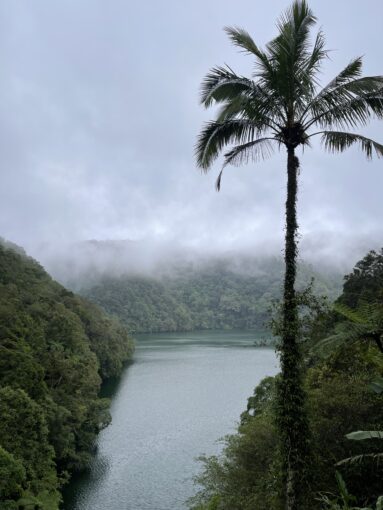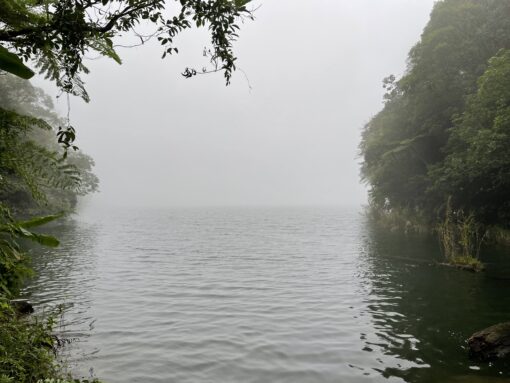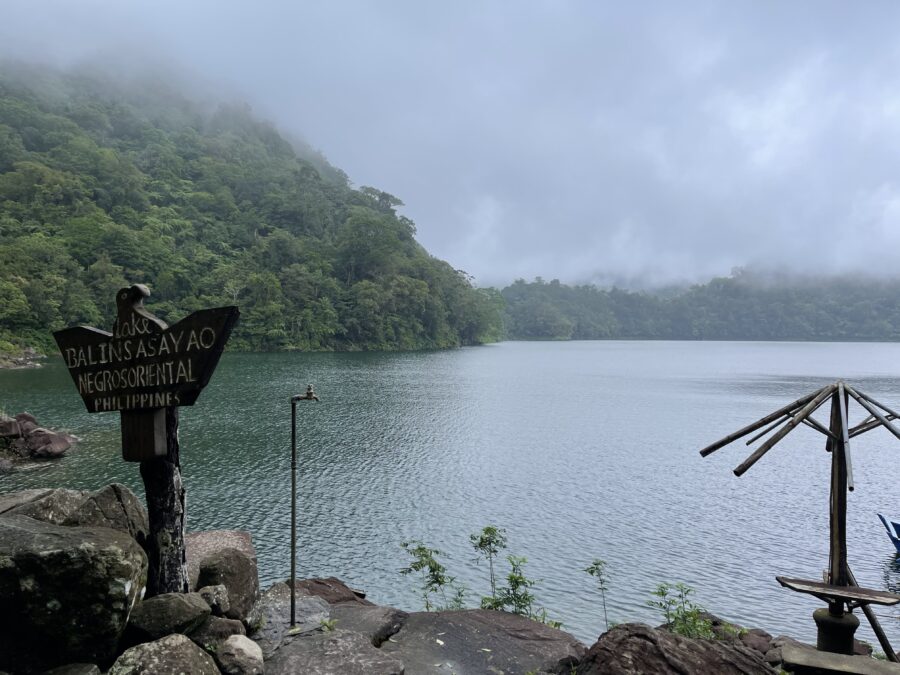Introduction to Lake Balinsasayaw and Lake Danao
Lake Balinsasayaw and Lake Danao, nestled in the municipality of Sibulan in Negros Oriental, are two picturesque bodies of water renowned for their stunning natural beauty and ecological importance. Both lakes are vital components of the local ecosystem, supporting a diverse array of flora and fauna, as well as serving as critical habitats for numerous bird species. These lakes are more than just scenic spots; they are pivotal for birdwatching enthusiasts and nature lovers alike.
Lake Balinsasayaw is particularly celebrated for its crystal-clear waters and lush surrounding landscapes. The lake is bordered by dense forests that serve as a backdrop to a vibrant avian community. This environment not only creates a habitat for various bird species but also provides an ideal setting for birdwatchers to observe them in their natural habitat. The serenity of Lake Balinsasayaw, coupled with its rich biodiversity, makes it a prime location for both casual visitors and serious ornithologists.
On the other hand, Lake Danao is equally significant, offering a different yet equally enchanting experience. Known for its unique ecosystem, Lake Danao is home to a variety of bird species, including migratory and resident birds that find refuge in its tranquil surrounds. The lake’s diverse aquatic and terrestrial habitats promote remarkable biodiversity, making it a notable destination for birdwatching. Here, enthusiasts can often spot a range of species, all thriving in their natural surroundings.
Both lakes play an essential role in the ecological balance of the region. They are instrumental in supporting local wildlife, educating visitors, and fostering a deeper appreciation for the natural world. Given their proximity to each other, Lake Balinsasayaw and Lake Danao provide an accessible and rich birdwatching experience, inviting all to explore the wonders of nature they have to offer.
The Ecological Importance of the Twin Lakes
The Twin Lakes of Sibulan, comprising Lake Balinsasayaw and Lake Danao, hold immense ecological significance due to their unique habitats and the diverse species they support. These lakes are situated in a region rich in biodiversity, characterized by various ecosystems that include freshwater, wetlands, and surrounding forests. The lakes serve as essential habitats for numerous bird species, making them a prime location for birdwatching enthusiasts. Species such as the Philippine duck, black-crowned night heron, and various kingfisher species can be observed in this thriving environment.
Within their waters, Lake Balinsasayaw and Lake Danao are home to a variety of aquatic life, including several endemic species, which are crucial for maintaining the ecological balance in the region. The lakes contribute to the local food web, hosting fish that not only support avian predators but also provide sustenance for local communities. This interdependence stresses the lakes’ significance in fostering healthy ecosystems and promoting biodiversity.

Moreover, both lakes play a pivotal role in water quality regulation and watershed management. They act as natural filters, purifying incoming water as it flows through the surrounding vegetation, thereby ensuring the health of aquatic ecosystems. Conservation efforts in the region are imperative to preserve these habitats. Local government initiatives, along with non-governmental organizations, focus on protecting the lakes from pollution, invasive species, and unregulated development. Efforts include establishing protected areas and promoting eco-tourism that raises awareness about the ecological value of the Twin Lakes.
Overall, the Twin Lakes of Sibulan represent a critical ecological asset, ensuring biodiversity and contributing significantly to the health of the environment. Their preservation is vital, not only for the species that inhabit them but also for the communities that rely on their resources.
Birdwatching Overview: A Thrill for Enthusiasts
The Twin Lakes of Sibulan, comprising Lake Balinsasayaw and Lake Danao, present a remarkable opportunity for birdwatching enthusiasts. The region’s rich biodiversity and unique ecosystems create a haven for a diverse array of bird species, making it a popular destination for both casual observers and seasoned birdwatchers alike. The lakes are part of a protected area, which has helped preserve the natural habitats that support these avian populations.

Lake Balinsasayaw is particularly noted for its abundance of resident and migratory birds. Visitors can expect to encounter species such as the Philippine turtledove, the black-crowned night heron, and various types of kingfishers, all of which add vibrant colors and sounds to the lakeside ambiance. In contrast, Lake Danao, surrounded by lush forests, offers a different yet equally captivating experience. Birdwatchers will find this area teeming with avifauna, including several endemic species that are endemic to the Philippines. This rich avian diversity makes birdwatching at the Twin Lakes an exhilarating pursuit.
The best times for birdwatching at these lakes are typically early morning and late afternoon when birds are most active. During these periods, the chances of spotting various species feeding, nesting, or exhibiting their unique behaviors significantly increase. Furthermore, the cool, tranquil atmosphere enhances the experience, allowing birdwatchers to engage fully with their surroundings. The interplay of light and sound during these hours not only provides optimal conditions for observing birds but also delivers a serene backdrop for reflection and appreciation of nature.
In summary, the Twin Lakes of Sibulan stand as an unparalleled destination for birdwatching enthusiasts due to their unique bird species, optimal viewing conditions, and enriched natural habitats. The combination of these factors makes the lakes a must-visit for anyone passionate about avian exploration.
Spotlight on Avian Species: The Negros Bleeding-Heart
The Negros bleeding-heart (Gallicolumba criniger) is a unique and captivating species endemic to the Philippines, particularly found on the islands of Negros and Panay. This avian creature is easily recognized by its distinctive coloration, featuring a striking combination of rich maroon and white plumage which closely resembles a heart shape on its chest. This remarkable appearance not only makes the Negros bleeding-heart a favorite among birdwatchers but also emphasizes its ecological importance within the local environment.
These birds typically inhabit forested regions, particularly montane forests and lowland jungles. Their preferred habitat consists of dense vegetation, where they can find ample food sources, such as seeds, fruits, and small invertebrates. The presence of the Negros bleeding-heart is vital for indicators of ecological health, as they rely on a stable environment to thrive. The decline in their population serves as an alarming sign of habitat degradation and deforestation, impacting not only their survival but the entire ecosystem connected to their presence.
Despite their beauty and significance, Negros bleeding-hearts face numerous challenges. Deforestation driven by agricultural expansion and urban development poses a significant threat to their natural habitat. In recent years, the encroachment of human activity has fragmented their environments, making it increasingly difficult for these birds to find food and mates. Additionally, climate change exacerbates the challenges faced by the Negros bleeding-heart, altering weather patterns and subsequently affecting food availability.
Efforts to protect the Negros bleeding-heart are crucial. Conservation programs aimed at habitat restoration, preservation, and awareness can help mitigate the threat to these birds. By prioritizing their protection, we can safeguard this unique species and, by extension, ensure the health of the broader ecosystem of the Twin Lakes of Sibulan.
The Majestic Visayan Hornbill
The Visayan hornbill, locally known as “katala,” is an iconic avian species endemic to the lush forests of the Visayan Islands in the Philippines. This striking bird, scientifically classified as *Penelopides panini*, is notable for its distinctive appearance, characterized by a large bill adorned with a prominent casque that can vary in color from yellow to orange, depending on the age and maturity of the bird. Adult males typically exhibit a black plumage with white underparts, while females possess a similar but slightly lighter coloration. These stunning features make the Visayan hornbill a sought-after sighting for birdwatchers exploring the pristine environments of Lake Balinsasayaw and Lake Danao.
The vocalizations of the Visayan hornbill are equally captivating. They communicate through a series of low, resonant calls, often described as “barking” or “bellowing” sounds that echo through the forest. These calls, which can be heard during mating rituals or territorial disputes, play an essential role in social interactions among individuals. Observing these vocalizations during birdwatching excursions adds depth to the experience, allowing enthusiasts to appreciate the bird’s behaviors and social structure while enhancing the overall ambiance of the pristine habitat.
The Flame-Templed Babbler: A Hidden Gem
The Flame-templed babbler (Stachyris speciosa) is a unique and elusive bird species found predominantly in the humid forests surrounding the Twin Lakes of Sibulan, particularly in the areas near Lake Balinsasayaw and Lake Danao. Known for its vibrant plumage that features fiery orange and yellow accents, this bird often becomes a favorite target for birdwatchers who visit the lakes. However, its cryptic coloration and furtive behavior can make it quite challenging to spot.
Characteristically, the Flame-templed babbler is a medium-sized bird that typically dwells in dense vegetation. Its remarkable adaptation to the forest environment allows it to remain concealed, often moving quietly through thick underbrush in search of insects and small fruits. Birdwatchers may notice its characteristic short tail and prominent eye stripes that enhance its facial features. Its melodious yet subtle calls can often be heard echoing through the forest, providing clues for birdwatchers trying to locate it.
To successfully observe the Flame-templed babbler in its natural habitat, it is recommended to approach its territory with patience and stealth. Early morning hours tend to be the most productive for birdwatching, as this is when the birds are most active. Utilizing binoculars with a good field of view will help in spotting this hidden gem as it flits from branch to branch. Listening attentively to its calls can also aid in narrowing down its location, as its songs are distinctively beautiful yet soft. Birdwatchers should remain quiet and respect the bird’s space, as sudden movements may easily startle it away, leaving observers waiting for the next fleeting glimpse.
Emphasizing the need for conservation, understanding the habits and habitats of the Flame-templed babbler will enhance appreciation for this intriguing species. Protecting the lush surroundings of the Twin Lakes not only ensures the survival of this bird but also enriches the overall biodiverse ecosystem that supports countless other species in the area.
Identifying the White-Winged Cuckooshrike
The white-winged cuckooshrike (Coracina leucopterus) is an intriguing bird commonly found in the lush habitats surrounding the Twin Lakes of Sibulan, particularly at Lake Balinsasayaw and Lake Danao. Recognizable by its striking features, this species exhibits a distinctive glossy black plumage complemented by contrasting white wings, which create a stunning visual against the verdant backdrop of its environment. The male and female cuckooshrikes display similar plumage, making visual differentiation primarily challenging for birdwatchers. Observers should pay particular attention to the bird’s size, which is approximately 26 cm in length, and its strong, hooked bill, which is adept for tearing into insects and fruit.
Feeding habits of the white-winged cuckooshrike revolve around a diet rich in insects and fruits, reflecting its role within the local ecosystem as a regulator of insect populations. These birds are often observed foraging in the canopy of trees or mid-level branches, using their keen eyesight to spot prey. Their adaptability allows them to thrive in various habitats, but they predominantly prefer areas with dense foliage and open spaces for foraging, making the lush surroundings of Twin Lakes an ideal environment for observing this species.
To enhance your chances of spotting the white-winged cuckooshrike during birdwatching excursions, consider visiting early in the morning or late in the afternoon when birds are most active. Maintaining silence and patience can be crucial; quickly scanning the branches with binoculars can yield sightings, especially when these birds call out their distinctive chirps, which echo through their habitats. Engaging with local birdwatching groups or utilizing bird identification apps may also provide valuable insights, enriching the overall experience of birdwatching at these scenic lakes.
The Nocturnal Negros Scops Owl
The Negros scops owl (Otus thongwong Coates) is a fascinating avian species endemic to the Philippines, particularly found in the rich ecosystems of Negros Island. Recognized for its unique nocturnal lifestyle, this owl thrives in forested environments, showcasing remarkable adaptations that aid in its survival and hunting practices. With a primarily carnivorous diet, the Negros scops owl preys on various small mammals, insects, and other birds, making it an integral component of the local biodiversity.
During nighttime excursions, the Negros scops owl’s hunting habits come to light. These owls are highly proficient hunters, utilizing their excellent hearing to detect the slightest sounds of movement. Once prey is identified, they employ a combination of stealth and agility, gliding silently to capture their meal. Their camouflaged plumage allows them to blend seamlessly into the surrounding environment, making them particularly elusive for potential observers.
Vocalizations play a crucial role in the behavior of the Negros scops owl. Their distinctive calls resonate through the night, serving various functions, including establishing territory and attracting mates. Birdwatchers often rely on listening skills to locate these owls, as their vocalizations can provide a good indication of their presence in a particular area. Campers and wildlife enthusiasts are encouraged to familiarize themselves with the specific calls to enhance their chances of spotting these fascinating creatures.
For those keen on birdwatching, the evenings around the Twin Lakes of Sibulan present an opportunity to encounter the Negros scops owl. Ideally, one should venture out during warmer months when these birds are most active. Using techniques such as slow, quiet movements and positioning oneself at listening points can significantly increase the likelihood of sighting this remarkable owl species. Observers should also consider bringing along a spotlight to aid in spotting movement, while being respectful of the owl’s habitat to ensure a successful and sustainable birdwatching experience.
Other Notable Species: The Visayan Shama and Negros Striped Babbler
Among the rich avian diversity found in the Twin Lakes of Sibulan, two species that capture the attention of birdwatchers are the Visayan shama (Copsychus cebuensis) and the Negros striped babbler (Pickhraornis marchandi). Both species exhibit distinct characteristics and behaviors that not only highlight their significance in the local ecosystems but also their vulnerability in the face of habitat loss.
The Visayan shama is a strikingly beautiful bird that has become a favorite subject for ornithologists and birdwatchers alike. This avian inhabitant boasts a glossy black plumage adorned with an orange underbelly. They are typically found in dense forests and are known for their melodious songs that resonate through the trees. These birds prefer low-lying areas around the lakes, often perching on branches where they can observe their surroundings. Their diet mainly consists of insects and fruits, which they forage from the forest floor.
In contrast, the Negros striped babbler is smaller and less flamboyant, sporting a brownish color with distinctive streaks on its back. This species thrives in the undergrowth of humid forests and is more elusive than the Visayan shama. The Negros striped babbler is often found in pairs or small groups, flitting between shrubs and low-hanging branches. Their calls are characterized by a series of distinctive whistles, making them easier to locate despite their reclusive nature. This bird primarily feeds on insects and is critical for maintaining insect populations in their habitat.
Both the Visayan shama and Negros striped babbler play essential roles in their ecosystems, contributing to insect control and seed dispersal. However, they face significant threats from habitat destruction and deforestation, making conservation efforts imperative. Birdwatchers visiting the Twin Lakes can appreciate the splendor of these species while also acknowledging the need to protect their natural habitats for future generations.













